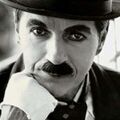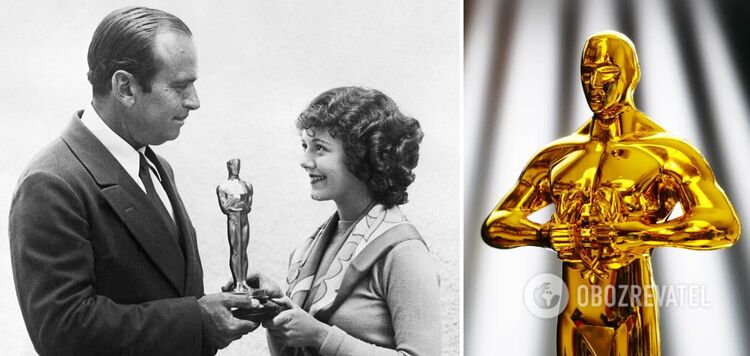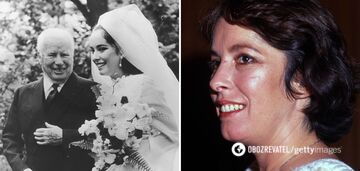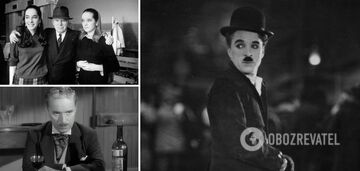
Charlie Chaplin
Charles Spencer Chaplin was born on April 16, 1889, in London. His mother, Hannah Hill, was a music-hall actress with a failed career. Charlie Chaplin's father first played mime skits, then became what was then called a "dramatic and genre singer." Personal and worldly turmoil of unsettled acting life did not bypass this family. Touring, life apart, affair on the side. Charlie and his half-brother Sidney grew up with his mother.
Chaplin senior lived in poverty and could not help them. To make ends meet, Hannah hired as a nurse, sewing for members of the church congregation. But their situation remained desperate. "We lived," Sidney recalled, "in a pauper's room and mostly starving. Neither Charlie nor I had shoes. I remember my mother taking my shoes off my feet and giving them to one of us whose turn it was to go for the poor man's soup, our only meal of the day..."
Poverty undermined Hannah's health. She was admitted to a clinic for the mentally ill, then placed in a workhouse. Sidney and Charlie wandered about. A few months later they were sent to the Hanwell Orphanage for homeless children. On November 12, 1898, Hannah was released from the hospital. Together with her sons she settled on Metley Street.
At the age of nine, Charlie found himself in the children's cockdance ensemble, the Eight Lancashire Boys. For two years he traveled with the ensemble through the English countryside. After Chaplin left the ensemble, performances of songs, dances, parodies alternated with the prosaic occupations of a newspaper clerk, deliveryman, a servant in a private home, printer in the printer, journeyman, even a dance teacher, woodsman and glassblower.
Charlie was eighteen years old when he found himself in Carnot's troupe. During the American tour of the troupe in late 1912 he was noticed by a representative of the film company "Keystone. A year later, after negotiating all the terms, Chaplin signed a contract with Keystone and moved to Los Angeles.
Comedy films with Chaplin had success. However, over time, he decided to put films himself. His first tape "Caught in the rain" was one of the best in Keystone. During the year at Keystone, he starred in a total of thirty-five paintings. Almost two-thirds of them were made by him, from their own scripts, or in collaboration.
In 1915 he released twelve films for the Chicago firm Esseney. The greatest success was "Champion," "Tramp," "Woman," "An Evening at the Music Hall. In these simple comedies appeared tramp Charlie. He was a banker, a house painter, a beggar, a policeman, a mechanic, a hobo, even Tarzan, even ... the beautiful Carmen! "The basis of all my films is the following course: I get into some trouble, trouble, but no matter what, with hopeless seriousness pretend as if nothing has happened to me," - wrote Charlie Chaplin.
In early 1916, he joined the firm Myuchuel "with a contract for 670 thousand dollars a year. The first film "controller of the department store," Chaplin made for "Myuchuel", was a great success. Each month he produced one comedy in two parts: "The Fireman," "The Wanderer," "At One o'clock in the Morning," "The Count," "The Moneylender's Shop," "Behind the Screen," ... The films "Tramp" and "Bank" were the first comedies Chaplin, which sounded dramatic and tragic overtones, so important in his mature work.
During World War I, Chaplin advertised the Freedom Loan, calling for donations to the army. It was probably then that he conceived the idea for the film Shoulder to Shoulder! This three-part comedy about the senseless brutality of war is one of Chaplin's greatest successes.
September 23, 1918 Charlie entered into marriage with fifteen-year actress Mildred Harris. He married hastily, because his young girlfriend claimed she was expecting a child. Then it turned out that the alarm was false.
Unsuccessful marriage caused Chaplin's creative crisis. In 1919 he shot only two films - "Sunny Side" and "Day of Entertainment.
Striving for independence, Chaplin, along with David Griffith, Mary Pickford and Douglas Fairbanks organizes a film company United Artists. And in 1922 the director creates his own company, Charles Chaplin Film Corporation.
July 7, 1919 Mildred gave birth to a son, Norman, but he lived only three days. Chaplin immerses himself in his work. Ten days after the tragedy, he was doing auditions, looking for a hero - a small child - for the new movie "Little Boy" (1920). On this film, Charlie spent more than a year, investing 300 thousand dollars. Some episodes reshot more than a hundred times! Chaplin said: "I want to make a serious picture in which irony, pity, satire will be hidden behind comic and burlesque episodes."
Shot from the film "The Kid".
Chaplin and Mildred Harris parted without mutual recriminations. However, journalists stirred up a high-profile scandal, and Mildred accused her husband of cruelty. During the divorce process, her lawyers threatened to confiscate the film Baby. Chaplin fled to Salt Lake City, taking the negative of the picture with him.
The most complete account of Chaplin's working methods at the time is contained in the memoirs of his secretary, Elsie Godd. Immediately upon arriving at the studio, Chaplin would assemble performers and his assistants. He spoke at length about the next scene of the film, explaining to each artist his role. Not content with this, Chaplin himself performed all the roles, male and female, in front of the members of the troupe. After that he proceeded to rehearsal, watching carefully the game of each actor, seeking sincerity and credibility of the game. Finally, having carefully checked the costumes and makeup, he proceeded to shoot. At this point, he was a complete change: all the previous preoccupation, businesslike disappeared, and all seemed carefree fun, which as if joking and improvising created interesting, funny tricks. Gradually Charlie infected his mood all the other actors. The finished film Chaplin showed in some theater in Los Angeles. He carefully watched, as the audience reacted, and made appropriate conclusions.
In 1925, Charlie Chaplin makes one of the best films of all time - "Gold Rush" (1925). Filmed with a rare ingenuity, forcing romantic and even tragic situations suddenly become comic. Chaplin himself considered this picture a masterpiece.
The action of "Gold Rush" refers to 1898. Through the icy deserts of Alaska moves a chain of gold diggers. One of them is Charlie, a small, kind, amorous man trying to live among rude, cruel, greedy people. He falls in love with a saloon girl. To entertain her, shows a dance of buns - a masterpiece of mimicry: two buns with forks stuck in them represent the dancer's legs eyes, eyebrows, Chaplin's lips give the dance a lyrical sadness, extraordinary expressiveness.
In this comedy Chaplin continued in the drama "Woman of Paris" (1923) in-depth development of the characters. The painting is distinguished by its organic integrity, concise and expressive cinematic language. One detail - and the audience an entire event, a vivid feature of the psychological portrait.
During the filming of "Gold Rush" Charlie Chaplin was forced to marry fifteen Lita Gray, who was waiting for his child, otherwise he was threatened with prison. With Lita, he lived for two years, they were born sons Sydney and Charlie. But to create a real family and failed ...
January 15, 1926 Chaplin proceeds to shoot "Circus" and worked on the film until the end of the year. But it covers a new scandal: in early December, Lita Gray, along with her sons moved to his mother. January 10, 1927 her lawyers filed for divorce. Charlie goes into hiding with his lawyer. Society is stirred by rumors of Chaplin's insanity and even suicide. Lita accused her husband of cruelty and immorality. Her statement to the court was 42 pages long. In the end, she received a million dollars in back pay and a hefty life annuity, and Chaplin ended up in a clinic for the mentally ill.
He comes out of the clinic completely gray. Conceived as a hilarious comedy, "Circus" takes on a grim tone: a stray who accidentally gets into the circus experiences great misfortune both in the arena and in love. In one scene, the monkeys severely bitten Chaplin, and he had to be treated for six weeks.
In March 1928, Chaplin began work on his first sound picture "Big City Lights" (1931), in which he developed two storylines: the love of the little tramp Charlie to a blind flower-girl and his friendship with an alcoholic millionaire. The film is literally permeated, saturated with charming melodies. The scene when the flower girl recognizes her benefactor in the pathetic ragamuffin is unbelievably powerful. Charlie's face under her questioning and then understanding gaze is one of the most expressive close-ups in the history of world cinema. Confused and shy smile, and pain, and love, and hope in his eyes!
Charlie Chaplin never became an American citizen, which angered many Hollywood conservatives. In America they tried to boycott "Big City Lights". Chaplin took the film to Europe, where a rapturous reception awaited him. The brilliant filmmaker met with Churchill, Welles, Shaw, the Prince of Wales... Chaplin was especially memorable visit to Einstein. The great scientist ended a lively conversation about the global economy with the words: "You're not a comedian, Charlie, you're an economist."
After learning from the telegram that "Big City Lights" was on the screen in America, Chaplin traveled to the Middle and Far East. He visited Africa, India, Indonesia, and finally Japan, where he was rumored to have been threatened by members of the fascist military organization Black Dragon.
In the spring of 1932, Chaplin returned to Hollywood and began making the film New Times (1936).
In July he met the actress Paulette Godard. They took long car rides, went on a yacht to Catalina. Of course, in "New Times," Paulette got the lead role! The film begins with a symbolic juxtaposition of a herd of sheep with a mob of workers spewed out by a factory. Tramp Charlie finds herself on the assembly line of an American factory. Barely out of the machine's grip, he finds the strength to patronize a young and equally defenseless girl.
After the success of "New Times", "Paramount" invited Paulette on a few films. And Chaplin decided to make a satirical film "The Great Dictator" (1940), mocking Hitler. In the midst of the director began to warn that he was waiting for trouble.
In "The Great Dictator" Chaplin played two roles - a humble Jewish barber Charlie and the fascist dictator Hinkel, which is easily recognized as Hitler. Even while working on the film Charles dropped the words that went around the world: "Dictators are funny. I want people to laugh at them. It is known that the film was sent to Hitler and Hitler himself saw the film. Upon hearing about it, Chaplin said: "I would have given anything to know what he thought of that film."
Chaplin in The Great Dictator
Chaplin in The Great Dictator
During the war, Chaplin fought against fascism as best he could: he wrote articles, gave speeches to soldiers. One day he was asked to speak at a rally of the Committee to Aid Russia in the War. Chaplin began his speech in San Francisco with a greeting of "Comrades!" and fervently called for help for the Russians.
As before, much of his mental energy was taken up by tangled personal affairs. In 1942, Paulette Godard divorced him in Mexico, citing as the reason for incompatibility of characters, as well as the fact of a long separation.
At this time, Chaplin was looking for an actress for the lead role in the film "The Ghost and Reality. He was offered to try 17-year-old Una O'Neil, the daughter of a famous playwright. She was not only beautiful, but also clever. And suddenly a new scandal broke out. Young actress Joan Barry went to court, demanding to recognize Chaplin as the father of her child. Comparative blood test refuted her words, but the court ordered Chaplin to pay Joan Barry allowance!
Hollywood never liked the brilliant filmmaker. Increasingly there were voices calling for Chaplin's deportation because of his leftist orientation and fascination with nymphets. At the height of scandal, June 15, 1943, the 54-year-old Chaplin and the young Una O'Neill married. Neither the advanced age of the groom, nor his small stature did not embarrass Una. Marriage to this amazing woman gave Charles the resilience to the storms and crises of the 1940s. Their family grew rapidly. Geraldine was the first to be born (1944), followed by Michael (1946), Josephine Hannah (1949), Victoria (1951)...
In May 1947 journalists again began to pester Chaplin with the question of why he did not want to take American citizenship. Charles replied: "I am an internationalist, not a nationalist, so I am not seeking citizenship. NBC arranged for his phone calls to be eavesdropped on.
In 1952, Chaplin puts on "Ramp lights." For more than three years, Chaplin had worked on the script of this picture. Its plot is simple: an old clown saves and returns to the creativity of the sick ballerina. In its original form, the script had seven hundred and fifty pages, covering material that went far beyond the plot, in particular the biography of the main actors, starting with their childhood. Chaplin played the role of the old artist Calvero.
Charles Chaplin predicted that "Ramp lights" would be his greatest and last picture. He gave the film autobiographical features.
On September 17, 1952, Chaplin sailed with his family to England. After months of travel, he chose to live permanently Manoir de Ban (Manor Exile) in Switzerland, in the town of Corsier-sur-Veve - a three-story villa, along with 37 acres of land. The family had four more children: Eugene (1953), Jane (1957), Annette (1959) and Christopher (1961).
In Switzerland, Chaplin and his wife had many friends. Among them were the Queen of Spain, movie stars and writers. In the spring, they had visitors from various countries.
Una was not only a wife to Chaplin, the mother of his children, a friend in adversity - she was his deity. The great actor and director's old age passed with this fragile, modest and lovely woman in remarkable harmony.
The preservation of financial freedom allowed Charles Chaplin in early 1956 to re-establish his own firm, which was named "Attica Film Company."
In 1957, the film "King of New York" came out. The image of King Shedow, banished from his kingdom and prostrate in New York, revived some of the traits of Charlie the Tramp. The film had a huge public response. The film was banned from release in the United States.
After The King in New York, Chaplin wrote his memoirs for six years. His book My Biography was published in 1964 and was translated into many languages. It became a bestseller, one edition after another. The University of Oxford awarded Chaplin an honorary degree of Doctor of Literature.
In 1967, Charles Chaplin put his latest film "The Countess from Hong Kong" - a salon comedy involving Sophia Loren, Marlon Brando and a few comedians. Charlie himself appeared only in a brief episode (the role of an old steward, suffering from seasickness). And although the critics found the picture unsuccessful, the name of a genius Chaplin ensured it a successful rental all over the world.
Chaplin was awarded the Legion of Honor for his outstanding services to world cinema. At the international film festival in Venice, Charles was also awarded the "Golden Lion" (1972). Noted Chaplin and the American Film Academy, awarding him an Oscar (1972) for outstanding contribution to cinema. The great Charlie had braced himself for attack, but his appearance at the ceremony caused a standing ovation. Stunned by such a reception, he could barely find the words and showed his famous trick with the pot.
In recent years, Chaplin has worked on versions of new scenarios (the total number of them reached almost two dozen), the voice of the full-length silent films. In October 1974, he came to London for the presentation of the album "My life in films. And in March of the following year, the Queen of England knighted him. The ceremony was an unqualified triumph for Chaplin.
Finally, on Dec. 25, 1977 Hollywood filmmakers, after a four-year struggle, allowed to release a film about the life and work of a brilliant actor and director - "The Tramp Gentleman.
Charles Spencer Chaplin died quietly on Christmas night, December 25, 1977, at the age of 88. He was modestly buried in the cemetery at the Anglican Church in Vevey.
Charlie Chaplin and the look-alike contest. True story.
There is a well-known fact from Charlie Chaplin's biography that he took part in a Charlie Chaplin look-alike contest. He did take part in one of these contests, but the contest was held at the San Francisco Theater, not in Monaco, San Francisco or Switzerland, as some sources indicate. History is silent about what place he took in the contest, but what is known is that Charlie did not even make it to the finals!
Source:http://k1no.ru/chaplin.htm
true story: http://biographera.net/biography.php?id=367




